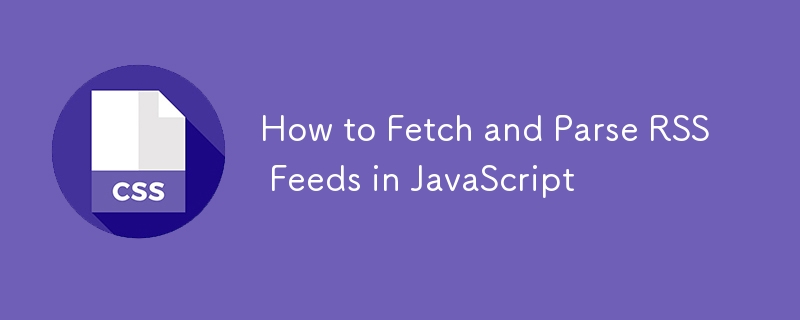
This guide demonstrates how to retrieve and process RSS feeds using JavaScript. RSS, an XML-based format, presents a slightly more complex parsing challenge compared to JSON. While many APIs favor JSON, RSS remains prevalent. This tutorial covers validation, network requests using the fetch API, and data manipulation.
First, validate the feed to ensure you're working with a valid response. Then, use fetch to make a network request:
- Fetch the RSS feed URL.
- Parse the response as text.
- Parse the text using
DOMParser(). - Utilize the parsed data.
Here's an example using the fetch API:
const RSS_URL = `https://codepen.io/picks/feed/`;
fetch(RSS_URL)
.then(response => response.text())
.then(str => new window.DOMParser().parseFromString(str, "text/xml"))
.then(data => {
const items = data.querySelectorAll("item");
let html = ``;
items.forEach(el => {
html = `
<img src="/static/imghw/default1.png" data-src="https://img.php.cn/" class="lazy" alt="How to Fetch and Parse RSS Feeds in JavaScript ">
<h2>
<a href="http://www.miracleart.cn/link/b36745962d5a1345e1b6dc85e9a80405" link target="_blank" rel="noopener">
http://www.miracleart.cn/link/b36745962d5a1345e1b6dc85e9a80405"title").textContent}
</a>
</h2>
`;
});
document.body.insertAdjacentHTML("beforeend", html);
});
The RSS data structure resembles nested HTML elements. The code above targets <item></item> elements, extracts relevant data (like link and title), and dynamically generates HTML elements to display the feed content.
Alternatively, you can use jQuery for a more concise solution:
const RSS_URL = `https://codepen.io/picks/feed/`;
$.ajax(RSS_URL, {
accepts: { xml: "application/rss xml" },
dataType: "xml",
success: function(data) {
$(data).find("item").each(function() {
const el = $(this);
const template = `
<img src="/static/imghw/default1.png" data-src="https://img.php.cn/" class="lazy" alt="How to Fetch and Parse RSS Feeds in JavaScript ">
<h2>
<a href="http://www.miracleart.cn/link/ea95de08542db1d94fe393abd1a5ce8d" link target="_blank" rel="noopener">
http://www.miracleart.cn/link/ea95de08542db1d94fe393abd1a5ce8d"title").text()}
</a>
</h2>
`;
document.body.insertAdjacentHTML("beforeend", template);
});
}
});
For production environments, consider server-side processing with caching to improve performance and security. This approach avoids relying directly on a third-party API for rendering critical content on your website. A server-side approach allows for scheduled updates (using CRON jobs, for example) and provides a faster, more reliable user experience.
The above is the detailed content of How to Fetch and Parse RSS Feeds in JavaScript. For more information, please follow other related articles on the PHP Chinese website!

Hot AI Tools

Undress AI Tool
Undress images for free

Undresser.AI Undress
AI-powered app for creating realistic nude photos

AI Clothes Remover
Online AI tool for removing clothes from photos.

Clothoff.io
AI clothes remover

Video Face Swap
Swap faces in any video effortlessly with our completely free AI face swap tool!

Hot Article

Hot Tools

Notepad++7.3.1
Easy-to-use and free code editor

SublimeText3 Chinese version
Chinese version, very easy to use

Zend Studio 13.0.1
Powerful PHP integrated development environment

Dreamweaver CS6
Visual web development tools

SublimeText3 Mac version
God-level code editing software (SublimeText3)

Hot Topics
 What is 'render-blocking CSS'?
Jun 24, 2025 am 12:42 AM
What is 'render-blocking CSS'?
Jun 24, 2025 am 12:42 AM
CSS blocks page rendering because browsers view inline and external CSS as key resources by default, especially with imported stylesheets, header large amounts of inline CSS, and unoptimized media query styles. 1. Extract critical CSS and embed it into HTML; 2. Delay loading non-critical CSS through JavaScript; 3. Use media attributes to optimize loading such as print styles; 4. Compress and merge CSS to reduce requests. It is recommended to use tools to extract key CSS, combine rel="preload" asynchronous loading, and use media delayed loading reasonably to avoid excessive splitting and complex script control.
 External vs. Internal CSS: What's the Best Approach?
Jun 20, 2025 am 12:45 AM
External vs. Internal CSS: What's the Best Approach?
Jun 20, 2025 am 12:45 AM
ThebestapproachforCSSdependsontheproject'sspecificneeds.Forlargerprojects,externalCSSisbetterduetomaintainabilityandreusability;forsmallerprojectsorsingle-pageapplications,internalCSSmightbemoresuitable.It'scrucialtobalanceprojectsize,performanceneed
 Does my CSS must be on lower case?
Jun 19, 2025 am 12:29 AM
Does my CSS must be on lower case?
Jun 19, 2025 am 12:29 AM
No,CSSdoesnothavetobeinlowercase.However,usinglowercaseisrecommendedfor:1)Consistencyandreadability,2)Avoidingerrorsinrelatedtechnologies,3)Potentialperformancebenefits,and4)Improvedcollaborationwithinteams.
 CSS Case Sensitivity: Understanding What Matters
Jun 20, 2025 am 12:09 AM
CSS Case Sensitivity: Understanding What Matters
Jun 20, 2025 am 12:09 AM
CSSismostlycase-insensitive,butURLsandfontfamilynamesarecase-sensitive.1)Propertiesandvalueslikecolor:red;arenotcase-sensitive.2)URLsmustmatchtheserver'scase,e.g.,/images/Logo.png.3)Fontfamilynameslike'OpenSans'mustbeexact.
 What is Autoprefixer and how does it work?
Jul 02, 2025 am 01:15 AM
What is Autoprefixer and how does it work?
Jul 02, 2025 am 01:15 AM
Autoprefixer is a tool that automatically adds vendor prefixes to CSS attributes based on the target browser scope. 1. It solves the problem of manually maintaining prefixes with errors; 2. Work through the PostCSS plug-in form, parse CSS, analyze attributes that need to be prefixed, and generate code according to configuration; 3. The usage steps include installing plug-ins, setting browserslist, and enabling them in the build process; 4. Notes include not manually adding prefixes, keeping configuration updates, prefixes not all attributes, and it is recommended to use them with the preprocessor.
 What are CSS counters?
Jun 19, 2025 am 12:34 AM
What are CSS counters?
Jun 19, 2025 am 12:34 AM
CSScounterscanautomaticallynumbersectionsandlists.1)Usecounter-resettoinitialize,counter-incrementtoincrease,andcounter()orcounters()todisplayvalues.2)CombinewithJavaScriptfordynamiccontenttoensureaccurateupdates.
 CSS: When Does Case Matter (and When Doesn't)?
Jun 19, 2025 am 12:27 AM
CSS: When Does Case Matter (and When Doesn't)?
Jun 19, 2025 am 12:27 AM
In CSS, selector and attribute names are case-sensitive, while values, named colors, URLs, and custom attributes are case-sensitive. 1. The selector and attribute names are case-insensitive, such as background-color and background-Color are the same. 2. The hexadecimal color in the value is case-sensitive, but the named color is case-sensitive, such as red and Red is invalid. 3. URLs are case sensitive and may cause file loading problems. 4. Custom properties (variables) are case sensitive, and you need to pay attention to the consistency of case when using them.
 What is the conic-gradient() function?
Jul 01, 2025 am 01:16 AM
What is the conic-gradient() function?
Jul 01, 2025 am 01:16 AM
Theconic-gradient()functioninCSScreatescirculargradientsthatrotatecolorstopsaroundacentralpoint.1.Itisidealforpiecharts,progressindicators,colorwheels,anddecorativebackgrounds.2.Itworksbydefiningcolorstopsatspecificangles,optionallystartingfromadefin






